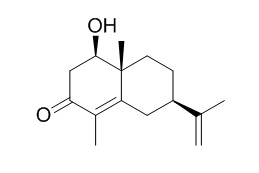Ligucyperonol
Ligucyperonol exhibits significant activities on protecting muscle cells from mild to moderate oxidative stress.
Inquire / Order:
manager@chemfaces.com
Technical Inquiries:
service@chemfaces.com
Tel:
+86-27-84237783
Fax:
+86-27-84254680
Address:
1 Building, No. 83, CheCheng Rd., Wuhan Economic and Technological Development Zone, Wuhan, Hubei 430056, PRC
Providing storage is as stated on the product vial and the vial is kept tightly sealed, the product can be stored for up to
24 months(2-8C).
Wherever possible, you should prepare and use solutions on the same day. However, if you need to make up stock solutions in advance, we recommend that you store the solution as aliquots in tightly sealed vials at -20C. Generally, these will be useable for up to two weeks. Before use, and prior to opening the vial we recommend that you allow your product to equilibrate to room temperature for at least 1 hour.
Need more advice on solubility, usage and handling? Please email to: service@chemfaces.com
The packaging of the product may have turned upside down during transportation, resulting in the natural compounds adhering to the neck or cap of the vial. take the vial out of its packaging and gently shake to let the compounds fall to the bottom of the vial. for liquid products, centrifuge at 200-500 RPM to gather the liquid at the bottom of the vial. try to avoid loss or contamination during handling.
J.Acta Agriculturae Scandinavica2017, 571-575
J. of Agricultural Science2015, 1916-9760
Int J Mol Sci.2023, 25(1):283.
Front Microbiol.2022, 12:833233.
Biomed Pharmacother.2024, 171:116166.
Pharmaceutics.2021, 13(2):187.
Biomed Pharmacother.2023, 162:114617.
Exp Biol Med (Maywood).2019, 244(18):1665-1679
J Pharm Anal.2016, 6(6):363-373
Molecules.2019, 24(11):E2102
Related and Featured Products
Planta Medica,2014,80(10):783-783.
Identification of phenolic compounds from the flower buds of Tussilago farfara and their antioxidative effects[Reference:
WebLink]
The dried flower buds of Tussilago farfara L. (Compositae) have been traditionally used to treat cough and asthma. There have been reports on various biological activities of its constituents such as anti-inflammatory, α-glucosidase inhibitory, and diacylglycerol acyltransferase (DGAT) inhibitory effect.
METHODS AND RESULTS:
As a part of our ongoing search for bioactive compounds from traditional herbal medicines, the flower buds of T. farfara were investigated and one new compound, 1-[(4S)-3,4-dihydro-4-hydroxy-2,2-dimethyl-2 H-1-benzopyran-6-yl]-ethanone (1), together with eight known compounds, 3,4-O-dicaffeoyl isoquinic acid (2), trans-cinnamic acid (3), 4-hydroxyacetophenone (4), 4,5-dicaffeoylquinic acid methyl ester (5), 3,5-dicaffeoylquinic acid methyl ester (6), 4-hydroxybenzoic acid (7), isoquercetin (8), Ligucyperonol (9) were isolated. Among them, compounds 2 – 4 have never been isolated from this plant previously. Their structures were identified by spectroscopic analysis including 1D and 2D NMR experiments.
CONCLUSIONS:
Moreover, all of the isolates were evaluated for their antioxidative effects and exhibited significant activities on protecting muscle cells from mild to moderate oxidative stress.



